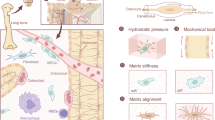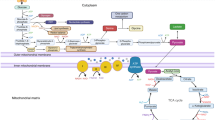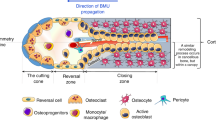Abstract
A large number of molecular, cellular, and epidemiologic factors have been implicated in the regulation of bone development. A major unsolved problem is how to integrate these disparate findings into a concept that explains the development of bone as an organ. Often events on the organ level are simply presented as the cumulative effect of all factors that individually are known to influence bone development. In such a cumulative model it must be assumed that each bone cell carries the construction plan of the entire skeletal anatomy in its genes. This scenario is implausible, because it would require an astronomical amount of positional information. We therefore propose a functional model of bone development, which is based on Frost's mechanostat theory. In this model the genome only provides positional information for the basic outline of the skeleton as a cartilaginous template. Thereafter, bone cell action is coordinated by the mechanical requirements of the bone. When mechanical challenges exceed an acceptable level (the mechanostat set point), bone tissue is added at the location where it is mechanically necessary. The main mechanical challenges during growth result from increases in bone length and in muscle force. Hormones, nutrition, and environmental factors exert an effect on bone either directly by modifying the mechanostat system or indirectly by influencing longitudinal bone growth or muscle force. Predictions based on this model are in accordance with observations on prenatal, early postnatal, and pubertal bone development. We propose that future studies on bone development should address topics that can be derived from the mechanostat model.
Similar content being viewed by others
Log in or create a free account to read this content
Gain free access to this article, as well as selected content from this journal and more on nature.com
or
References
Bell JI 1999 Clinical research is dead; long live clinical research. Nat Med 5: 477–478
Erlebacher A, Filvaroff EH, Gitelman SE, Derynck R 1995 Toward a molecular understanding of skeletal development. Cell 80: 371–378
Hogan BL 1996 Bone morphogenetic proteins: multifunctional regulators of vertebrate development. Genes Dev 10: 1580–1594
Parfitt AM 1990 Bone-forming cells in clinical conditions. In: Hall BK (ed) The Osteoblast and Osteocyte, Vol 1. Telford Press, Caldwell, NJ, pp 351–429
Parfitt AM 1994 The two faces of growth: benefits and risks to bone integrity. Osteoporos Int 4: 382–398
Lanyon LE 1992 Control of bone architecture by functional load bearing. J Bone Miner Res 7( suppl 2): S369–375
Turner CH, Burr DB 1993 Basic biomechanical measurements of bone: a tutorial. Bone 14: 595–608
Carter DR, van der Meulen MCH, Beaupre GS 1996 Skeletal development: mechanical consequences of growth, aging and disease. In: Marcus R, Feldman D, Kelsey J (eds) Osteoporosis. Academic Press, San Diego, pp 333–350
Heaney RP 1995 Bone mass, the mechanostat, and ethnic differences. J Clin Endocrinol Metab 80: 2289–2290
Lanyon LE 1996 Using functional loading to influence bone mass and architecture: objectives, mechanisms, and relationship with estrogen of the mechanically adaptive process in bone. Bone 18: 37S–43S
Frost HM 1987 Bone “mass” and the “mechanostat”: a proposal. Anat Rec 219: 1–9
Qin L, Mak AT, Cheng CW, Hung LK, Chan KM 1999 Histomorphological study on pattern of fluid movement in cortical bone in goats. Anat Rec 255: 380–387
Aarden EM, Burger EH, Nijweide PJ 1994 Function of osteocytes in bone. J Cell Biochem 55: 287–299
Donahue HJ 2000 Gap junctions and biophysical regulation of bone cell differentiation. Bone 26: 417–422
van der Meulen MC, Ashford MW Jr, Kiratli BJ, Bachrach LK, Carter DR 1996 Determinants of femoral geometry and structure during adolescent growth. J Orthop Res 14: 22–29
Burr DB 1997 Muscle strength, bone mass, and age-related bone loss. J Bone Miner Res 12: 1547–1551
Martin RB, Burr DB, Sharkey NA 1998 Skeletal Tissue Mechanics. Springer Verlag, New York
de Vries JI, Visser GH, Prechtl HF 1985 The emergence of fetal behaviour: II. Quantitative aspects. Early Hum Dev 12: 99–120
Frost HM, Jee WS 1994 Perspectives: a vital biomechanical model of the endochondral ossification mechanism. Anat Rec 240: 435–446
Frost HM 1997 Why do marathon runners have less bone than weight lifters? A vital-biomechanical view and explanation. Bone 20: 183–189
Rauch F, Travers R, Parfitt AM, Glorieux FH 2000 Static and dynamic bone histomorphometry in children with osteogenesis imperfecta. Bone 26: 581–589
Parfitt AM 1997 Genetic effects on bone mass and turnover: relevance to black/white differences. J Am Coll Nutr 16: 325–333
Christensen FC, Rayburn WF 1999 Fetal movement counts. Obstet Gynecol Clin North Am 26: 607–621
Rowe DW, Shapiro JR 1998 Osteogenesis imperfecta. In: Avioli LV, Krane SM (eds) Metabolic Bone Disease and Clinically Related Disorders, 3rd Ed. Academic Press, San Diego, pp 651–695
Carter DR, Orr TE, Fyhrie DP, Schurman DJ 1987 Influences of mechanical stress on prenatal and postnatal skeletal development. Clin Orthop 219: 237–250
Burke SW, Jameson VP, Roberts JM, Johnston CED, Willis J 1986 Birth fractures in spinal muscular atrophy. J Pediatr Orthop 6: 34–36
Rodriguez JI, Palacios J, Garcia-Alix A, Pastor I, Paniagua R 1988 Effects of immobilization on fetal bone development: a morphometric study in newborns with congenital neuromuscular diseases with intrauterine onset. Calcif Tissue Int 43: 335–339
Rodriguez JI, Garcia-Alix A, Palacios J, Paniagua R 1988 Changes in the long bones due to fetal immobility caused by neuromuscular disease: a radiographic and histological study. J Bone Joint Surg Am 70: 1052–1060
Rodriguez JI, Palacios J, Ruiz A, Sanchez M, Alvarez I, Demiguel E 1992 Morphological changes in long bone development in fetal akinesia deformation sequence: an experimental study in curarized rat fetuses. Teratology 45: 213–221
Rodan GA 1991 Mechanical loading, estrogen deficiency, and the coupling of bone formation to bone resorption. J Bone Miner Res 6: 527–530
Frost HM 1999 On the estrogen-bone relationship and postmenopausal bone loss: a new model. J Bone Miner Res 14: 1473–1477
Forest MG, Ducharme JR 1993 Gonadotropic and gonadal hormones. In: Bertrand J, Rappaport R, Sizonenko PC (eds) Pediatric Endocrinology, 2nd Ed. Williams & Wilkins, Baltimore, pp 100–120
Rodriguez JI, Palacios J, Rodriguez S 1992 Transverse bone growth and cortical bone mass in the human prenatal period. Biol Neonate 62: 23–31
Trotter M, Peterson RR 1970 The density of bones in the fetal skeleton. Growth 34: 283–292
Trotter M, Hixon BB 1974 Sequential changes in weight, density, and percentage ash weight of human skeletons from an early fetal period through old age. Anat Rec 179: 1–18
Bernard J, Laval-Jeantet M 1962 Le rapport cortico-diaphysaire tibial pendant la croissance. Arch Franc Pediat 19: 805–817
Bonnard GD 1968 Cortical thickness and diaphysial diameter of the metacarpal bones from the age of three months to eleven years. Helv Paediatr Acta 23: 445–463
Trotter M 1971 The density of bones in the young skeleton. Growth 35: 221–231
Einhorn TA 1996 Biomechanics of bone. In: Bilezikian JP, Raisz LG, Rodan GA (eds) Principles of Bone Biology. Academic Press, San Diego, pp 25–37
Maresh MM 1961 Bone, muscle and fat measurements: longitudinal measurements of the bone, muscle and fat widths from roentgenograms of the extremities during the first six years of life. Pediatrics 28: 971–984
Beyers N, Alheit B, Taljaard JF, Hall JM, Hough SF 1994 High turnover osteopenia in preterm babies. Bone 15: 5–13
Greer FR, McCormick A 1986 Bone growth with low bone mineral content in very low birth weight premature infants. Pediatr Res 20: 925–928
James JR, Congdon PJ, Truscott J, Horsman A, Arthur R 1986 Osteopenia of prematurity. Arch Dis Child 61: 871–876
Helin I, Landin LA, Nilsson BE 1985 Bone mineral content in preterm infants at age 4 to 16. Acta Paediatr Scand 74: 264–267
Horsman A, Ryan SW, Congdon PJ, Truscott JG, Simpson M 1989 Bone mineral content and body size 65 to 100 weeks' postconception in preterm and full term infants. Arch Dis Child 64: 1579–1586
Fewtrell MS, Prentice A, Jones SC, Bishop NJ, Stirling D, Buffenstein R, Lunt M, Cole TJ, Lucas A 1999 Bone mineralization and turnover in preterm infants at 8–12 years of age: the effect of early diet. J Bone Miner Res 14: 810–820
Congdon PJ, Horsman A, Ryan SW, Truscott JG, Durward H 1990 Spontaneous resolution of bone mineral depletion in preterm infants. Arch Dis Child 65: 1038–1042
Schanler RJ, Burns PA, Abrams SA, Garza C 1992 Bone mineralization outcomes in human milk-fed preterm infants. Pediatr Res 31: 583–586
Lapillonne AA, Glorieux FH, Salle BL, Braillon PM, Chambon M, Rigo J, Putet G, Senterre J 1994 Mineral balance and whole body bone mineral content in very low-birth- weight infants. Acta Paediatr Suppl 405: 117–122
Hori C, Tsukahara H, Fujii Y, Kawamitsu T, Konishi Y, Yamamoto K, Ishii Y, Sudo M 1995 Bone mineral status in preterm-born children: assessment by dual-energy X-ray absorptiometry. Biol Neonate 68: 254–258
Garn SM 1972 The course of bone gain and the phases of bone loss. Orthop Clin North Am 3: 503–520
Bass S, Delmas PD, Pearce G, Hendrich E, Tabensky A, Seeman E 1999 The differing tempo of growth in bone size, mass, and density in girls is region-specific. J Clin Invest 104: 795–804
Schiessl H, Frost HM, Jee WS 1998 Estrogen and bone-muscle strength and mass relationships. Bone 22: 1–6
Schoenau E, Neu CM, Mokov E, Wassmer G, Manz F 2000 Influence of puberty on muscle area and cortical bone area of the forearm in boys and girls. J Clin Endocrinol Metab 85: 1095–1098
Kovacs CS, Kronenberg HM 1997 Maternal-fetal calcium and bone metabolism during pregnancy, puerperium, and lactation. Endocr Rev 18: 832–872
Frost HM, Jee WS 1994 Perspectives: applications of a biomechanical model of the endochondral ossification mechanism. Anat Rec 240: 447–455
Krabbe S, Christiansen C, Rodbro P, Transbol I 1979 Effect of puberty on rates of bone growth and mineralisation: with observa2tions in male delayed puberty. Arch Dis Child 54: 950–953
Fournier PE, Rizzoli R, Slosman DO, Theintz G, Bonjour JP 1997 Asynchrony between the rates of standing height gain and bone mass accumulation during puberty. Osteoporos Int 7: 525–532
Blimkie CJ, Lefevre J, Beunen GP, Renson R, Dequeker J, Van Damme P 1993 Fractures, physical activity, and growth velocity in adolescent Belgian boys. Med Sci Sports Exerc 25: 801–808
Bailey DA, McKay HA, Mirwald RL, Crocker PR, Faulkner RA 1999 A six-year longitudinal study of the relationship of physical activity to bone mineral accrual in growing children: the university of Saskatchewan bone mineral accrual study. J Bone Miner Res 14: 1672–1679
Alffram PA, Bauer GC 1962 Epidemiology of fractures of the forearm: a biomechanical investigation of bone strength. J Bone Joint Surg Am 44-A: 105–114
Landin LA 1983 Fracture patterns in children: analysis of 8,682 fractures with special reference to incidence, etiology and secular changes in a Swedish urban population 1950–1979. Acta Orthop Scand Suppl 202: 1–109
Bailey DA, Wedge JH, McCulloch RG, Martin AD, Bernhardson SC 1989 Epidemiology of fractures of the distal end of the radius in children as associated with growth. J Bone Joint Surg Am 71: 1225–1231
Cameron N, Tanner JM, Whitehouse RH 1982 A longitudinal analysis of the growth of limb segments in adolescence. Ann Hum Biol 9: 211–220
Tanner JM, Hughes PC, Whitehouse RH 1981 Radiographically determined widths of bone muscle and fat in the upper arm and calf from age 3–18 years. Ann Hum Biol 8: 495–517
Author information
Authors and Affiliations
Corresponding author
Rights and permissions
About this article
Cite this article
Rauch, F., Schoenau, E. The Developing Bone: Slave or Master of Its Cells and Molecules?. Pediatr Res 50, 309–314 (2001). https://doi.org/10.1203/00006450-200109000-00003
Received:
Accepted:
Issue date:
DOI: https://doi.org/10.1203/00006450-200109000-00003
This article is cited by
-
Association between walking speed and calcaneus stiffness index in older adults
Journal of Bone and Mineral Metabolism (2023)
-
Einfluss von Pubertät und Hormonen auf die Knochenentwicklung
Gynäkologische Endokrinologie (2023)
-
Quantifying calcium changes in the fetal spine using quantitative susceptibility mapping as extracted from STAGE imaging
European Radiology (2022)
-
Characteristics of healthy German children and adolescents across tertiles of calcaneal stiffness index
Journal of Public Health (2022)
-
Comparison of DNA preservation between adult and non-adult ancient skeletons
International Journal of Legal Medicine (2022)



